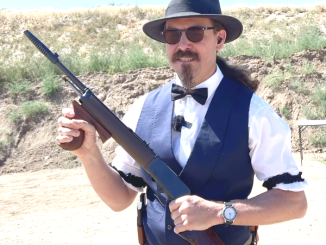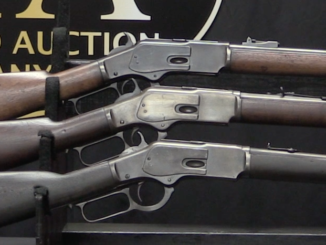RIA’s catalog page for this pistol
The M15 General Officer’s pistol was the replacement for the Colt Model M, which had long been the military issue sidearm for General-level officers. By the late 1960s, however, the supply of Model M pistols was running out, and Colt no longer had the design (the Pocket Hammerless) in production. Dale Hoffman, Superintendent of Small Arms at Rock Island Arsenal designed his own shortened (4.25 inch barrel) and accurized 1911 and submitted it to the Army unsolicited as a replacement for the Model M.
This resulted in trials in 1971, where Hoffman’s gun was put up against both steel and aluminum framed S&W Model 39s, a 9mm Colt Series 70, and a Walther P38. Hoffman’s design came out the best, and was formally adopted in 1972. Between 1972 and 1974, the Rock Island Arsenal converted 1004 stock 1911A1 pistol into M15s, and they were issued out until 1982, when the supply was exhausted. At that point, General officers began to be issued standard 1911A1 pistols, and later Beretta 92s. As an interesting side note, any General issued an M15 had the option of purchasing it from the government for $147 upon retirement – and I would presume that most took that option.




Hey Ian, except for the the fact that these pistols were converted from 5″ Government model pistols and with a few upgrades, it seems that they were nothing more than commercial model Colt “Combat Commander” pistols.
I had the chance to buy one from a gun shop I worked at in 1981the owner of the Shop was a retired Con.From the US Marines ..They are much more than a Combat Comander..Like they came from Colts Coustom shop fit and finish was first Rate..plus it was owned by an Officer of$2500 was the price no discount not even for me..My father owned 2 that were stolen in 1974 with 318 other guns..like fleet like a fine watch in the hand..
I wonder what would have happened if P14-45 was one of entries
http://modernfirearms.net/en/handguns/handguns-en/canada-semi-automatic-pistols/para-ordnance-p14-45-eng/
Just couple of years after…. and, also in 9mm Para. Yet, the same familiar 1911.
I am wondering, what would be result, if they would include Browning Hi-Power in their testing.
Choice of steel and aluminum framed S&W Model 39s, a 9mm Colt Series 70, and a Walther P38 looks haphazard of me. Is that full list of competitors or only final round (i.e. chosen from more options)? If first, it looks for me like total disregard for other NATO member in regard to their automatic pistol, like for example that Browning Hi-Power (as L9 in British service) or MAC modèle 1950 used in France.
The thing I never got with these was the logic of the M15 designation. Have there been 14 other General Officer’s pistols? How did we go backwards to M9, if these are merely pistols?
I’m sure there was a logic, but I have not a clue what it is, and I can’t remember ever seeing it written down.
“I’m sure there was a logic, but I have not a clue what it is, and I can’t remember ever seeing it written down.”
Per analogy with USAAC during WWII, they might have prototypes for which they assigned designation starting with X, which might become accepted (for example Lockheed XP-38 -> P-38 Lightning) or not – then resulting in empty numbers.
Or they might just choose random number.
Colt should have brought back the 1905 Model .45 …. 🙂 I always preferred it’s compactness and dimensions over the 1911. More of a gentleman’s gun, the 1911 was a darn massive horse pistol. Closest equivalent today is the TT-33. I’d like to see a .45 ACP TT-33.
“Closest equivalent today is the TT-33”
Actually TT is smaller than handguns developed by F.V.Tokarev earlier.
Today these branch are called respectively small [automatic] pistol of Tokarev and big [machine] pistol of Tokarev, for photos see: http://historypistols.ru/blog/pistolety-pod-unitarnyj-patron-avtomaticheskie/opytnye-obrazcy-pistoletov-tokareva/
Chapter 7,63-мм большой автоматический пистолет Токарева, опытный образец 1929 года
contains photos of big Tokarev machine pistol, which was response to following requirements: mass no more than 2,5 kg, capacity: 20-25
Pistol crafted by Tokarev was 2,225 kg (with empty magazine), overall length: 465 mm, capacity: 22, cartridge: 7,63×25 Mauser, it has detachable magazine, but could be also loading via strippers holding 10 rounds (cf. Steyr-Hahn), principle of operation is short recoil, it is selective-fire weapon which might fire both in single and full-auto. Wooden stock might be attached, sights were scaled to 700 m.
Chapter 7,62-мм малый автоматический пистолет Токарева, опытный образец 1929 года shows smaller version of weapon described above. Overall length 310 mm, mass is 1,668 kg with empty magazine, capacity 22. Rate of Fire was 1000 rpm, big rate of jams means it was unsuitable for adoption for service.
Chapter 7,62-мм большой самозарядный пистолет Токарева, опытный образец 1930 года shows improved version of weapon described as first, it could fire only in single and has alterations made to improve reliability, but nonetheless some disadvantages remained.
Chapter 7,62-мм малый самозарядный пистолет Токарева, опытный образец 1930 года
shows direct ancestor of TT-30, as you might guess from photo
“both steel and aluminum framed S&W Model 39s, a 9mm Colt Series 70, and a Walther P38”
Walther P38? What it was doing there? Did they buying bigger number seriously or it was just control sample?
It was most likely the token non-American design in the trials, probably chosen because it had a good repuation from WW2, and it was still used by the West German Army.
Terrible font with the markings. Looks like something on a hallmark card.
waste of government money just like the Rock Island Arsenal still does today
I find it amusing that so much time and money was spent on pistols for the soldiers least likely ever to have to use them.
That said, the General Officers’ .45 looks like a neat upgrade of the old 1911. It would have been nice if the Army could have found the money to modify the pistols issued to the soldiers who actually needed them. Now there’s a thought.
Very US Army like to actually trial several different candidates in order to replace an insignificant number of weapons, which are very unlikely to ever be used in anger even if there’s a war going on…
The logical choice would have been to adopt a suitable handgun already in service with the US Army and still in production. If the standard M1911A1 was deemed too cumbersome for general officers, the Smith & Wesson Model 12 woulds have been a good candidate, or alternatively the Colt Cobra. If the most common 2″ barrel would have been, let’s say not manly enough for Generals, both were available with longer barrels. The Cobra was not made with a 4″ barrel as standard, but a 3″ one would probably be the best choice in any case. If a still longer barrel would have been desired, I am sure Colt could have made a batch od Cobras for the US Army with a 4″ barrel.
“Very US Army like to actually trial several different candidates in order to replace an insignificant number of weapons, which are very unlikely to ever be used in anger even if there’s a war going on…”
In comparison in Soviet Union during Cold War there was not bigger desire to make heavily modified (by shortening or something similar) weapon specially for generals. This probably has source in fact that Makarov automatic pistol was designed as weapon for higher-ranking officers, while Stechkin machine pistol was supposed to be used by front-line commanders. For making it outstand from others there was option of special (fancy) finish, see 2nd and 4th photos here: http://www.bratishka.ru/archiv/2003/2/2003_2_6.php
“(…)Smith & Wesson Model 12(…)Colt Cobra(…)”
But that would mean .38 Special cartridge, while enumerated handguns trialled were firing at least 9×19 Parabellum cartridge, though I do not know if they automatically rejected all handguns firing weaker cartridge or fail to find such weapons full-filing other criteria.
Yes it would, but the general officers were previously using pistols in .380 Auto, which is also a much weaker cartridge than 9mm Parabellum or .45 ACP. Furthermore, the revolvers in .38 Special remained in active service with the US Army until the late 1980s.
Does any know how I can download a copy of the owners manual for Rock Island M15 General Officers acp45 pistol manual?
Hi, my uncle has one of these in South Texas. Serial # GO912, it doesn’t have original pistol grips or magazine! About 80-85% condition. What would be the value of it?